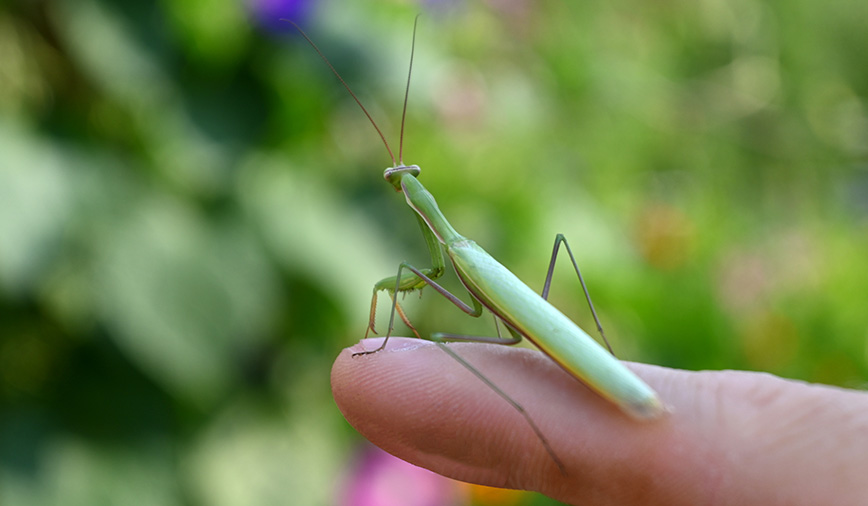Pam’s Perspective
From the…
Pam Otto is the Manager of Natural Programs and Interpretive Services for the St. Charles Park District
July 5, 2012
Whoever said parenting is not for sissies knew exactly what he, or she, was talking about.
I know this because I’ve recently taken on the completely self-imposed challenge of life in the maternal fast lane. I’ve not only witnessed the birth (well, okay, hatching) of nearly 200 wee ones, but also have watched them take their first steps (gingerly, on six legs); eat their first meals (which consisted mostly of each other); take their first drinks of water (through tiny mandibles); and compete for survival, during which time many heads rolled—literally.
Eventually, after many trials and tribulations, one individual emerged victorious over his 190 or so siblings. Welcome to the world, Manny—a.k.a. Tenodera sinensis, the Chinese mantid or praying mantis.
As his self-appointed guardian, I’ve more than once found myself on pins and needles as Manny has battled back from such setbacks as an incomplete molt (he dragged a portion of his shed skin around on one hind leg for several days); the day his world turned upside down (yeah…I dropped his jar…); and, most devastatingly, a prey insect that fought back, severing one of Manny’s front legs. (Note to self: Take ants off Manny’s menu.)
This foray into insect “parenthood” began two months ago when Jill Voegtle, a member of our ecological restoration team, brought in an egg case she’d found. Firmly attached to a stem of native honeysuckle, the case (also known as an ootheca) looked a lot like a blob of Great Stuff – that aerosol foam sealant you can buy at the hardware store – and a little like a roasted marshmallow. The stem soon joined our own collection of “great stuff” (assorted insects and their parts) that we use in teaching Bug Biographies, a program for local second graders.
Roughly 400 7- and 8-year-olds, plus teachers and parent volunteers, got to see the ootheca and speculate at its contents during the first few weeks of May. But the 100 or so students and assorted adults who came to Bugs the last week in May got to see the real deal—Manny and his dozens of brothers and sisters, duking it out inside a large jar.
We not only had an extremely visual representation of the mantids’ ability to control insect populations (namely their own), but we also had an ethical dilemma on our hands.
At Hickory Knolls we abide by a strict code of never taking native animals from the wild just to put them on display. But Chinese mantids are from, well, China. Imported as a biological alternative to insecticides, they have been in this country for about 100 years. They can be found throughout the northeastern United States, and in recent years have become increasingly prevalent here in northern Illinois.
Even though they were brought here intentionally, their presence now is being reexamined. They’re great predators of insects, yes, but they’re also indiscriminate. While they prey upon the bugs we have in abundance, like grasshoppers, they’ll also eat their share of pollinators like honeybees – insects we have far too few of these days.
After a short debate, we decided we will keep Manny indoors. He will live out his days as a display animal, a member of the Hickory Knolls insect education squad.
The decision itself was relatively easy, but the effort to make it sustainable has sometimes been tough. After a long day at work I often found myself heading, not to my car, but to the lights that dot Hickory Knolls’ exterior, to hand-pick teensy insects for baby Manny. Last weekend, instead of simply walking the dog, I took along an insect net and bug jar, to sweep the tall grass and gather somewhat larger insects for a somewhat larger Manny, who molted again last Sunday.
But the work has been worth it. Our boy has let us observe, up close and personal, his growth and development, and helped us advance our knowledge of these amazingly complex creatures.
One of the first things we checked was Manny’s abdominal segments. We counted eight, confirming that he is indeed a male. (Female Chinese mantids have six abdominal segments. Despite this smaller number, females grow to be quite a bit larger than males and, somewhat famously, have proportionately larger appetites .)
We’ve also marveled at Manny’s astonishingly mobile head. Mantids are one of a very few insects that possess a functional neck; they can and will move their heads to look you in the eye. The resulting effect is a creature that appears both wise and mysterious, with a dash of E.T. thrown in for good measure.
True to his order, the Mantodea, Manny did not pass through an ambiguous larval form but instead has looked like a classic mantid since Day One. With front legs raised and claws clasped, he’s been praying—actually, preying—ever since.
Even after his unfortunate injury, which left him with just one raptorial forelimb, Manny is able to hunt with the best of them. He’ll stand stock-still, waiting, as his insect meal creeps ever closer. Then, with lightning speed, he lashes out and pierces his prey with a needle-sharp tibial claw, grasping it against the
spines that dot his tibia and femur. He then moves in with his powerful mandibles, gnashing and tearing the insect to bits. Afterward, he delicately nibbles his way along his foreleg, meticulously cleaning away leftover bug bits in preparation for his next ambush.
Now over an inch in length, Manny is magnificent and strong, a young mantid on a mission. Surrounded by small wings and legs—the crumbs of meals past—he’s no sissy, that’s for sure. I can only hope the same is true for me.

